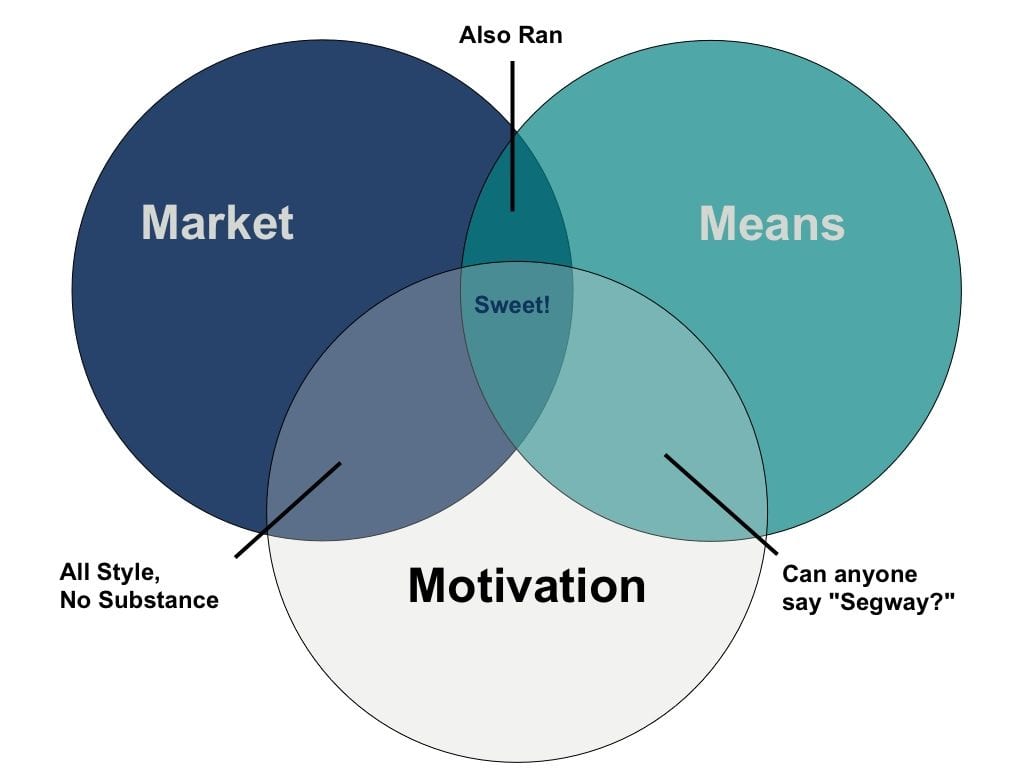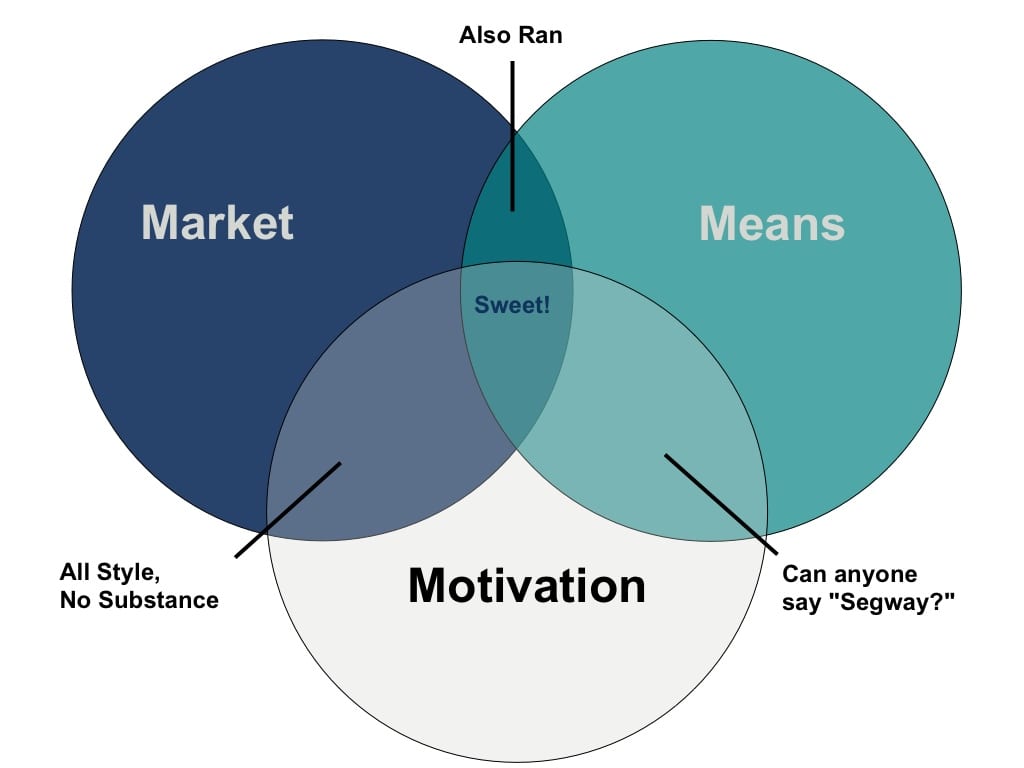
Ever struggle to determine whether an idea is a good one? Whether it is really a good fit for your business, something that really deserves to be pursued? In this post, I share a deceptively simple visual I use for focusing my business ideas.
I call it the “3M” model – not because it has anything to do with Post-It notes (though those can be useful!), but because it focuses on three factors that I think are essential for success with a business or even a specific product (like an online course).
These are: market, means, and motivation.

In a nutshell, there has to be demand for the product you plan to sell (market), you have to have the capabilities necessary for creating and delivering it (means), and for real success, you have to truly driven to create significant value through making the product available (motivation).
If any of these factors is weak or missing, your efforts will be off center – as suggested in the graphic above – and you will either fail entirely or be much less successful than you could be.
I cover each of these areas in more detail in what follows and also include links to a range of tools I hope you will find helpful.
Market
A large percentage of the e-mails I get are from readers who are worried about whether there is demand for their product, how to price their product, and how to promote or advertise their product.
My response always – because I have seen it work again and again for myself and many others – is that the best way to be sure there is demand for a product is to focus on a market you already know reasonably well and begin offering content into that market that aligns with the product you plan to create – things like blog posts, brief videos, or white papers.
In other words, make all the right efforts to cultivate and build an audience.
Do people respond? How strong is the response, and what can you learn from it to make your product more successful? There’s a reason for the old saying “Nothing ventured, nothing gained.” You have to stick your neck out a bit, and these days, doing that in cost effective ways is easier than ever.
Whether or not you know the market well, another key step for assessing demand is to use search, particularly on Google and Amazon, to determine what is already out there that is getting traction. You want evidence that people are actually looking for the kinds of solutions you can offer. Otherwise, your product launch will be a shot in the dark.
For a full run down of specific tools and approaches you an use to validate your market, see:
The bottom line is that you can’t expect to know your market – and, by extension, know how to position, price, and promote – unless you have done the work above.
What are your plans for doing this work?
Means
Are you actually capable of creating the product you need to win in your market?
On the one hand, this question has to do with your actual expertise. I find that most of the people who sign up for my e-mail list are bona fide experts in whatever their subject area is, not wannabes from the “I’ve read three books on the topic, so I know more than you” camp. Naturally, we all have to put in the effort continually to maintain and build our expertise. So, to the extent you haven’t already, put some time into thinking about what you will read, watch, attend, etc. to “sharpen the saw” on an ongoing basis.
Of course, on the other hand, you have the matter of the tools and know-how necessary to create an online course.
The good news there is that creating and selling courses is exponentially easier than it used to be. As you probably already know, I list a range of platform options in 15 Platforms to Publish and Sell Online Courses.
I’ve also curated a valuable set of tools in my free Learning Revolutionary’s Toolbox (which I update regularly). You have all of these at your disposal. And, you can check out the big list of free online training for course creators.
If you still feel like creating a great product is beyond your capabilities, reasonably priced help is now easier to get than ever on sites like Upwork, 99 Designs (which I used for the Learning Revolution logo), Fiverr, and a range of others that I also cover in the The Learning Revolutionary’s Toolbox.

Basically, given your existing expertise and the huge range of free and low cost tools available as well as access to people with skills in just about any area you would need, there’s not a lot of excuse for not pulling together the means for success.
Of course, whether or not you do that depends heavily on the next factor …
Motivation
In many ways, motivation is the both the toughest to tackle and the most important out of these three success factors.
It’s a persistent problem with many of my organizational clients: the people in charge of creating and delivering educational products really have no significant interest in or passion for the topics the cover, and worse, they don’t really seem to have a sense of how the products can change lives for the better.
In a word, they lack vision.
This tends to be less of a problem with solo subject matter entrepreneurs and small business owners. These people – and you are likely one of them – tend to do what they do because they are intrinsically motivated. This motivation is incredibly important when it comes to pushing through the tough spots, being bold with your pricing as well as outreach to customers and partners, and in general, doing the work that make a business or product successful.
That said, another place where motivation is critical is in setting and sticking to your priorities. This is an area in which I find many edupreneurs flounder. I get a lot of e-mails from readers about not being able to find the time to create and launch a course, but time is always a matter of priorities, and priorities flow from – you guessed it – motivation.
So, it is well worth spending some time examining your own motivations and bringing your motivations and priorities into alignment. This will lead to approaches like the “only productivity tip you will ever need” that I highlighted in a recent e-mail. I also recommend this recent post by Jeff Bullas, in which he talks about “deep work” – a concept made popular by Cal Newport – and how the habit he developed base on deep work transformed his life.
If you feel like you don’t understand your own motivations well, it is worth using tools like:
Take any of these tools with a grain of salt: there is no such thing as a questionnaire that can reveal all of the secrets of what makes you tick. Even so, just the process of going through these kinds of assessments can help you focus your thinking and really home in on the vision for your product.
Aiming for the Strategic Sweet Spot
So, there you have it: market, means, motivation – the 3M Model.
As you head into any new business venture – or, revisit what you are doing currently – it is well worth spending some time reflecting on each of these factors and figure out whether you have all three working in your favor. If not, you either need to determine whether you can adjust and improve the factor – or, you need to consider finding a different idea to pursue.
See also:
- The Power of Naming
- The Key to Long-Term Success as an Edupreneur
- 5 Long-Term Challenges of the Edupreneur
Table of Contents
Related Posts
400+ Unique YouTube Channel Name Ideas For Popular Niches
Crowdcast Review (2024) | Key Features, Pros, & Cons
How to Write a Course Description That Sells